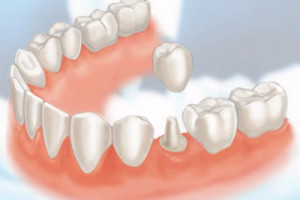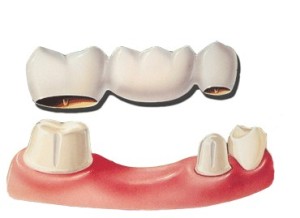Having a dazzling, healthy smile can make a positive difference in anyone’s life. It can restore not only one’s youthful appearance, but also the confidence and self-esteem that come with it. We welcome patients with high aesthetic expectations.
We offer a full range of of restorative dental procedures…
Tooth Colored Fillings
Tooth colored fillings are also referred to as composites. Tooth colored fillings are bonded to teeth supporting the remaining tooth structure, deterring breakage as compared to silver – amalgam fillings. Tooth colored fillings are harder and more durable than silver – amalgam fillings. Best of all, composite resins allow us to keep more of your natural tooth structure intact than amalgams. We believe in conservative dentistry, the more natural tooth structure you keep, the better teeth you will likely have in the future.
 Crowns
Crowns
Also called caps, crowns are natural looking covers that fit securely over teeth to conceal cracked, badly discolored, injured, or chipped teeth that cannot be restored with fillings or other types of restorations. Crowns minimize physical discomfort and provide support to damaged teeth. Ultimately, crowns can improve the overall appearance of your smile while making your teeth more resistant to injury. Although there are several types of crowns, porcelain are the most popular because they resemble your natural tooth.
Bridges
 Dental bridges literally bridge the gap created by one or more missing teeth. A bridge is made of two crowns on the anchoring teeth on either side of the gap, which are called abutment teeth, and a false tooth or teeth in between to fill the gap. These false teeth are called pontics and can be made from gold, alloys, porcelain or a combination of these materials. Dental bridges are supported by natural teeth and/or implants.
Dental bridges literally bridge the gap created by one or more missing teeth. A bridge is made of two crowns on the anchoring teeth on either side of the gap, which are called abutment teeth, and a false tooth or teeth in between to fill the gap. These false teeth are called pontics and can be made from gold, alloys, porcelain or a combination of these materials. Dental bridges are supported by natural teeth and/or implants.
There are three types of bridges:
- Traditional bridges involve creating a crown for the tooth or implant on either side of the missing tooth, with a pontic in between. Traditional bridges are the most common type of bridge and are made of either porcelain fused to metal or ceramics.
- Cantilever bridges are used when there are adjacent teeth on only one side of the missing tooth or teeth.
- Maryland bonded bridges or resin bonded bridges are supported by a metal framework. Metal wings on each side of the bridge are bonded to existing teeth.
Dentures and Partials
 A denture is a removable replacement for missing teeth and surrounding tissues. There are two types of dentures are available – complete and partial dentures. Complete dentures are used when all the teeth are missing, while partial dentures are used when some natural teeth remain.
A denture is a removable replacement for missing teeth and surrounding tissues. There are two types of dentures are available – complete and partial dentures. Complete dentures are used when all the teeth are missing, while partial dentures are used when some natural teeth remain.
Full Dentures
Full Dentures are an excellent option for people who have lost all their teeth. Precisely designed and molded to fit one’s mouth, full dentures slide over the gums and are held in place with strong cheek and mouth muscles. They allow for comfortable chewing and keep the mouth and its surrounding facial features in proper alignment.
Conventional or Immediate
- Full dentures can be either of conventional or immediate nature. Convetional dentures are made after the teeth have been removed and the gum tissue has begun to heal, They are usualy ready for placement in the mouth about 8 to 12 weeks following the procedure.
- Immediate dentures are made in advance and can be positioned as soon as the teeth are removed.
- Dr. Pierce will discuss the advantages and disadvantages with you in detail.
Partial Dentures
Partial or removable dentures fill gaps left by missing teeth. Partial dentures are held in place with metal clasps or precision devices (tooth-colored, discreet clasps) that are attached to natural teeth. Usually made of resin or metal, partial dentures allow more comfortable and effective chewing, improve speech, and prevent sagging of the cheeks and lips.
